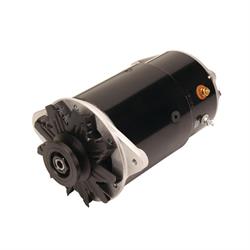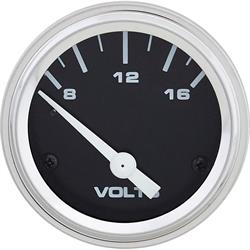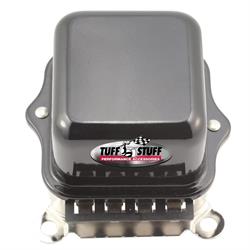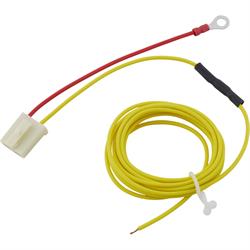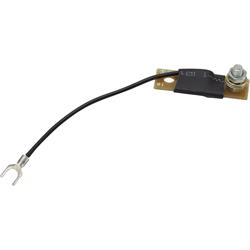Alternator vs Generator Pros & Cons | Conversion Tips for Your Car
Difference Between Alternator and Generator
Generators and alternators are both devices that convert mechanical energy into electrical energy to charge a car’s battery as it is depleted by the electrical accessories. While they both serve the same purpose, there are major differences between a generator vs. alternator. A generator uses a rotating armature inside static magnets to induce electrical current, while an alternator does this by rotating the magnetic field inside the conductor.
Put simply, magnetism and relative motion are the two components necessary to generate electricity. When a magnetic field moves relative to a wire, voltage is created in the wire. In the case of automotive charging systems, the necessary motion is usually created by a belt from the spinning engine that turns either a generator or an alternator. While their purpose is the same, there are structural differences between generators and alternators that cause them to function differently.
In a generator, the belt rotates an armature that is made up of coils of wire inside permanent magnets in the case. The relative motion between the armature and the static magnets in the case induces a current in the armature. Power is pulled off the armature and distributed back to the battery.
Then what is an alternator? An alternator functions in much the opposite way when compared to a generator. On an alternator, the belt from the engine spins the alternator pulley and thereby the internal rotor, which has alternating N and S poles, past the static coils of wire in the stator. The alternating polarity of the rotor creates alternating current (AC), which is then pulled from the stator, converted to DC current by a rectifier section of diodes, and distributed to the rest of the charging system.
Why Do Cars Use Alternators Instead of Generators?
Early in the development of the automobile, it was recognized that something would have to replenish the battery as current was consumed by things like electric starters, lights, and ignition systems. Early cars used generators spun by the engine to “generate” current to charge the battery. As automotive electrical systems evolved and became more demanding of current, generators became unable to keep up. In the early 60’s, alternators replaced generators under most hoods.
A key piece of the auto alternator vs generator conversation is the fact that generators are especially bad at creating current at low speeds. In automotive applications, that means idling around town. So, on those American Graffiti Saturday nights of yore, those slow trips up and down the main drag with the lights on, stopping at every red light and blasting The Beach Boys through the AM radio meant that the generator was working awfully hard to keep the electrons flowing. These days, you can spot that car at the cruise night that still has a generator by the dim headlights when it’s stopped at the light. Alternators have a major advantage over generators at low speeds. That’s how your new SUV can putter around town with the kids’ tablets charging, lights, stereo, electric fuel pump, and electric power steering all pulling current and still not deplete the battery. This, along with the fact that alternators tend to require less maintenance and last longer than generators, is why you want an alternator in your classic car or truck.
Generator to Alternator Conversion | Swap Tips
If you’re ready for a generator to alternator conversion, here are some tips and things to consider:
Internal or External Regulator
A generator or an alternator needs type of device to control how much current it’s putting back into the battery to prevent overcharging and damage to the battery or worse. This is done with a voltage regulator. There are both internal and external voltage regulators. External regulators were used by GM until the early 70’s, and those early regulators controlled alternator output with mechanical contacts not unlike breaker points in a distributor. Instead of simply being open or closed, these points cycle very rapidly to precisely govern battery voltage. Internal regulators and later external regulators use transistors to handle the current regulation. As you would expect, each of these situations will be wired into your car differently. You will need to identify what style of alternator your using. Consulting a GM alternator identification guide (or whatever make alternator you’re working with) will help you figure out what you have.
Ammeter vs voltmeter
We may be spending most of our time under the hood for our generator to alternator swap, but there’s an important piece of the generator v alternator puzzle inside the car on the dash. Whether your car is equipped with an “idiot light,” an ammeter, or a voltmeter will impact the way that new alternator will be wired up. Most modern cars or contemporary restomods will use a voltmeter, which simply reads the voltage in the system. 12-volt batteries typically need about 14.2 volts for the cells to charge, and the voltmeter will let you know if the alternator is doing its job or not.
But voltmeters weren’t always standard practice. In the old days, ammeters were equipped to most cars that didn’t simply have a warning light to indicate low voltage. Ammeters simply monitored the current in the charge wire and indicated “charge” or “discharge.” The ammeter vs voltmeter question is an important part of planning your alternator conversion.
A couple things happen when using an ammeter with an alternator. First, the alternator will do a much better job of keeping the battery charged and providing the necessary current to power the accessories, so the ammeter won’t really tell you much unless the alternator is failing. Another, and potentially more serious thing to consider, is the fact that the new alternator is likely going to be generating a lot more current. That old generator was likely regulated to somewhere around 30 amps, while your new alternator could be casually throwing over 100 amps at the battery. Ammeters “sampled” charge current through either a shunt or (amazingly) an inductive loop, through which all the current must pass. Tripling the amperage flowing through the gauge, whether shunt or inductive style, can be dangerous. Unless you’re terribly worried about keeping your factory gauges, your best bet will be a voltmeter to accompany your alternator conversion.
Change Accessory Brackets
With all this talk about wiring, it can be easy to forget that your alternator to generator conversion will likely need some type of generator to alternator conversion bracket or brackets to physically bolt your new alternator up to the engine. When it comes to alternator vs generator pros and cons, alternators score another win when it comes to size. But that compact packaging will also typically necessitate a dedicated alternator mount bracket to situate your new alternator where it needs to be to align with your existing pulleys. Take care when shopping for a new bracket or accessory drive system not to pick a setup that will crash your alternator into a tall valve cover, fenderwell, hood side, or carburetor. For some applications, there are dedicated generator to alternator conversion kits that will come with the best bracket for the application.
Use the Appropriate Wire Gauge
The increased charging capability is a key piece of the alternator vs generator difference and why we’re converting in the first place. This means that the wiring through which those extra electrons will be passing also needs to be heavy enough to carry the current without creating extra resistance. Resistance creates heat, and heat increases resistance. It’s a vicious cycle that can create a serious issue, and using wire that’s too small can create a dangerous and inefficient system, especially when it comes to the charge wire on a single wire alternator conversion. As long as the charge wire is running a short distance under the hood to the battery or starter lug, consider using 8-gauge wire on an alternator with 55-65 amp output, 6-gauge wire with a 65-100 amp alternator, and 4-gauge wire on anything over 100 amps. Longer runs will need to be even bigger (longer runs of wire cause more resistance). Screwing a 4-gauge wire to the back of your alternator may seem like “over-wiring” but think of it this way; you wouldn’t put a single 2” exhaust on your big block muscle car, don’t kneecap your charging system in the same way.
Make Sure it’s Grounded
Here’s one that’s bit us before. Say you’ve just finished that alternator swap and everything, even the accessory bracket, is powdercoated or painted. You start it up and realize that your freshly wired alternator is not charging. Remember that in most cases the alternator is grounded to the block or chassis through the case, and there’s a good chance that your fresh powdercoat is preventing the alternator from grounding. Either add a ground strap or remember to grind off coating to provide a clear ground path for the alternator.
Converting Generator to Alternator Wiring Diagram
There is no “one size fits all” schematic to cover an alternator conversion how to wire an alternator as a generator because it’s going to be somewhat different on every car. However, the schematic below is a high-level version that shows various versions of a converting generator to alternator wiring diagram.
Essentially, what you’re seeing here is a few common scenarios for GM and Ford wiring to generators as well as various alternator styles to give you a high-level view of what might need to be changed when converting your car. Plan to do some extra research here for anything specific to your car and if you’re concerned about keeping your stock indicator light or ammeter.
Also plan to do some research if your generator to alternator conversion is also a 6-volt to 12-volt conversion. Some early cars that used generators were also 6-volt systems. Just plugging in a 12-volt alternator will be dangerous and destructive. In addition to the other wiring concerns, consider using transistorized voltage reducers on remaining 6-volt devices like stock gauges.
Classic Car Alternator VS Generator Lookalike
When it comes to alternator vs generator pros and cons, alternators are better in every way except one; sometimes they just don’t look right under the hood of a vintage car. Whether it’s a restoration of a 50’s car or a traditional hot rod, an alternator will stick out like a sore thumb if every other detail under the hood predates the point in history where alternators became prominent. The solution is an alternator disguised as a generator. Powermaster offers a line of one-wire alternators in generator-lookalike cases. The PowerGEN alternator is available in various configurations for everything from Model A 4-bangers to flatheads to 50’s GM applications. We’ve used these in the past and they’re slick and reliable. These are an especially great solution to swap out a flathead generator when a flathead Ford alternator kit will look out of place. The flathead Ford alternator brackets in most Ford flathead alternator conversions put that modern alternator front and center, where it often looks very out of place.
Ultimately, the only reason to run a generator these days is if you’re after absolute period correctness. If your car’s electrical accessories consist of little more than the ignition, brake lights, and occasional headlights, you might just be ok with an old school generator. However, if your car has been updated with things like electric fans, fuel pumps, air conditioning, and a fancy stereo system, you will likely find that a generator just isn’t up to the job. An appropriately sized and properly wired alternator will keep the battery charged and offer far better reliability when you’re out on the road.
